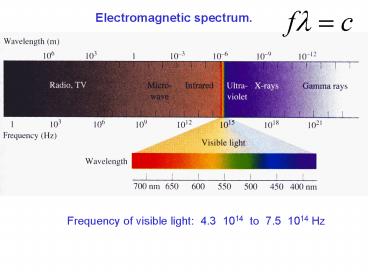Electromagnetic spectrum' PowerPoint PPT Presentation
1 / 12
Title: Electromagnetic spectrum'
1
Electromagnetic spectrum.
Frequency of visible light 4.31014 to
7.51014 Hz
2
Why a single wave phenomenon is called so many
names?EM waves of different frequencies/lengths
originate from different sources and interact
with matter essentially differently.
3
Electromagnetic Waves
http//www.phy.ntnu.edu.tw/java/emWave/emWave.html
http//www.amanogawa.com/archive/PlaneWave/PlaneWa
ve-2.html
http//www.walter-fendt.de/ph14e/emwave.htm
http//www.educypedia.be/electronics/javawaves.htm
4
Electromagnetic Waves
- The E and B fields are perpendicular to each
other - Both fields are perpendicular to the direction of
motion - Therefore, EM waves are transverse waves
- Propagate with the speed of light, which does not
depend on either frequency or amplitude - Speed of light in vacuum a fundamental
constant, - c 3?108 m/s
In every point in space, at each moment of time
5
Polarization is a property of electromagnetic
waves that specifies the direction of electric
field.Why do we pick the electric field out of
the two? Arent they on an equal footing?
They are on an equal footing, but it is mostly
the electric field, which interacts with matter
atoms, electrons, nuclei
6
EM waves from a TV tower are perfectly polarized
the Electric field has a very well defined
direction, which stays always the same. In
contrast, the light coming from the Sun or from a
light bulb is unpolarized.What does it mean
unpolarized? Does not the electric field have
some direction?
It certainly does at every instant. BUT this
direction does not stay constant and changes very
rapidly and randomly. So, averaging over any
reasonable time interval you do not find any
particular polarization!
polarized
The frequency of light is about 51014 Hz, which
means 51014 wave crests per second. If the
polarization changes once every 500 crests it
will still be 1012 times per second. Too fast for
us to detect!
unpolarized
7
Any way to make a polarized wave (light) out of
unpolarized wave?Yes, but it is going to cost
us some intensity loss (No free meals)
We can use a polarizer - a piece of material,
whose molecular or crystal structure has a
preferred direction called the transmission axis.
A polarizer decomposes the wave into a proper
component with the electricfield, ,
parallel to the transmission axis, which passes
through, and a wrong component with
perpendicular to the transmission axis, which
gets totally absorbed.
8
In an unpolarized wave, the angle q is changing
randomly. Therefore, after passing through a
polarizer the average intensity is
The magnitude of the proper component of the
electric field
z
Intensity of the wave is proportional to the
square of the amplitude
Law of Malus
transmission axis
The light gets polarized, but we loose 1/2 of
its intensity...
9
If the axis of a polarizer is set at q 90 to
the axis of polarization
no light is passing through!
A system of two crossed polarizers never lets any
light through.Whatever passes through the first
one is blocked by the second.
10
What happens to the intensity, S, and direction
of polarization of unpolarized light upon passing
trough three polarizers shown here?
E
E
E
S S3
S1
S2
Without the second polarizer
http//www.colorado.edu/physics/PhysicsInitiative/
Physics2000/applets/lens.html
11
EM Waves by an Antenna
- Two rods are connected to an ac source, charges
oscillate between the rods (a) - As oscillations continue, the rods become less
charged, the field near the charges decreases and
the field produced - at t 0 moves away from the rod (b)
- The charges and field reverse (c)
- The oscillations continue (d)
12
Electromagnetic Waves Produced by an Antenna
- When a charged particle undergoes an
acceleration, it radiates energy - If currents in an AC circuit change rapidly, some
energy is lost in the form of EM waves - EM waves are radiated by any circuit carrying
alternating current - An alternating voltage applied to the wires of an
antenna forces the electric charge in the antenna
to oscillate

